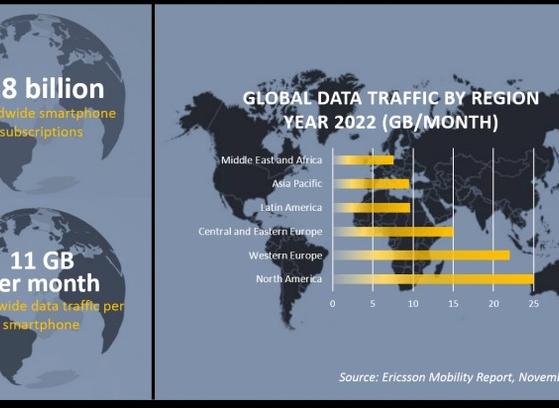In the not too distant future (2020+), we will be driven by autonomous cars, be treated by robots controlled by surgeons located on the other side of the world, have emergency help almost as soon or even before we know we need it, have energy- and water-efficient cities with recycled waste, never encounter traffic jams, be able to stream video (and holograms) anywhere, and will know exactly when our bus is arriving. This last at least is already widely achieved in many countries — including even parts of the UK, and in reality many of the points above are already partially realised with some early commercial implementations worldwide.

Source: Evolution and Revolution towards 5G, Kim Young Sik SVP Head of Network Technology Sept, Korea Telecom
Last week's 5G World Conference in London provided an opportunity to gauge the latest on what the industry are prioritising for roll-out. The challenge is vast and so is the opportunity — with a predicted 50 billion devices and €800 billion M2M market in 2020.

Source: The Role of the MNO in IoT Networks, Dr Mike Short, VP Telefonica Europe
In order to meet the diverse use cases — including smart meters, connected cars, mission critical apps, smart cities, multimedia, connectivity with high speed mobility — each with its own specific technical requirements, over what will likely be diverse RATs each with its own air interface, and shared infrastructure, the concept of network slicing is introduced in 5G.
Source: Evolution and Revolution towards 5G, Kim Young Sik SVP Head of Network Technology Sept, Korea Telecom
Network slicing allows the traffic for a specific use case to be effectively handled across the whole network, optimising network parameters to achieve for example, for an automotive use case - security, reliability and latency. The concept requires additional interfaces to be defined and also an understanding of how shared network equipment, even cloud nodes, can be configured to prioritise the use case traffic.

Source: Key Concepts of the 5G Core Architecture Evolution: Network Slicing and Convergence, Maria Cuevas, Head of Core Network Research, BT
The 5G core network architecture will also be changed — NGMN describes a native SDN and NFV architecture that structurally separates hardware and software, and covers mobile/fixed devices, infrastructure, network functions, value enabling capabilities and all the management functions to orchestrate the 5G system. APIs are provided on the relevant reference points to support multiple use cases, value creation and business models.
Source: 5G Architecture, NGMN 5G Whitepaper
Not only that, spectrum allocation also needs to address the differing needs of M2M — for low power and massive connectivity; of ubiquitous coverage and high throughput; and of critical communications — for low latency and high reliability, as described by Federico Boccardi of Ofcom UK.
Source: Federico Boccardi, Principal Technology Advisor Ofcom UK
So there you go, a whistlestop tour of 5G.
Will we fully roll out 5G by 2020?
Rahul Joshi Deputy CTO Reliance Jio provided a small reality check by sharing the complexities and challenges Reliance Jio encountered when rolling out VoLTE, not least due to the fact that VoLTE implementations do not quite yet work together according to IR.92 specifications, and VoLTE conformance testing is not yet mandatory.
Source: Evaluating the Underlying Complexities and Challenges of VoLTE, Rahul Doshi Deputy CTO Rajasthan Region, Reliance Jio
The 5G complexities are magnitudes larger, but slowly more and more “5G” use cases are already being realised, as LTE networks are upgraded to meet the necessary requirements.
Turk Telecom have already deployed the first smart cities in Karaman and Antalya, realising 30% increase water and electric efficiency, and 40% reduced accidents.
Source: Delivering the Smart City Vision in Turkey, Mehmet Ali Akrca, CEO Corporate Business Unit, Turk Telecom
In 2017 UK EE's LTE network for emergency services will go live, replacing the current ultra-reliable TETRA system, enabling services such as forwarding vital patient information from ambulance to hospital, live video from police officers' body cameras, and fire crews' tablet access of burning building blueprints.
Telecom Italia and Orange shared initiatives to support alternative access technologies (NB-IoT and LoRa respectively) to realise the smart metering segment, which has low power and massive connectivity requirements.
Arun Bansal SVP and Head of Business Unit Radio Ericsson, shared Ericsson's ability to offer 5G Plug-ins to enable Low latency, Massive MIMO, Intelligent connectivity, MU-MIMO and RAN Virtualisation, and announced achievement of 7GBps data rates in a moving vehicle.
Source: 5G Moves Out of the Labs and into the Neighbourhood, Arun Bansal SVP and Head of Business Unit Radio Ericsson
Chen Yifang VP LTE Network, Huawei Technologies spoke of 4.5G bridging to 5G, allowing support for faster speeds, improved user experience, more connections and CloudRAN.
Source: 4.5G, Bridging to 5G, Chen Yifang VP LTE Network, Huawei Technologies
As we move towards the flexibility of 5G architecture, it is ever more critical to get a real-time 24/7 understanding of the subscriber experience - “subscriber” in the generic sense across the many use cases in the 5G network.
Infovista's TEMS solutions enable increased remote monitoring and assessment of networks, automated analysis of network performance, coupled with the ability to predict network capacity issues and recommend actions based on big data correlations with information such as own and competing operator performance, population density, even weather. We have decades of expertise in network performance.
Please contact us to discuss how we can help make your 5G, LTE and VoLTE deployments a success.


















